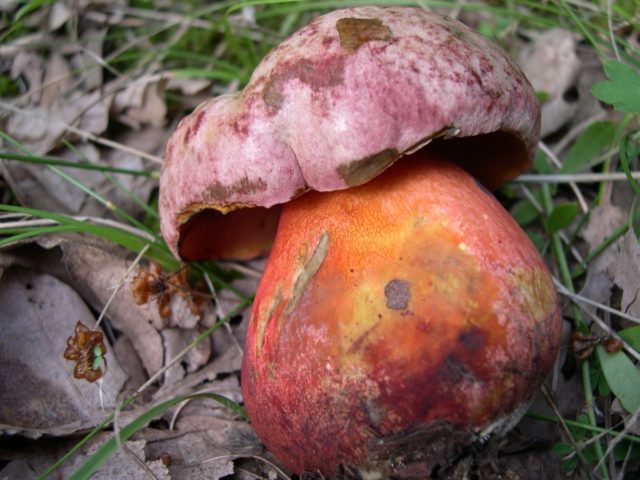Content
The pink-purple boletus is a member of the Boletaceae family. The only synonym for this species is Boletus rhodopurpureus. When meeting it, you should be careful, since this specimen belongs to the category of inedible mushrooms, despite the fact that in some countries it is eaten.
What do pink-purple boletuses look like?
At the initial stage of development, the cap of the pink-purple boletus is spherical, later it acquires a convex or cushion-shaped shape with wavy edges. The surface is dry and velvety, but during rains it becomes slimy and lumpy. In adulthood, cracks appear on it, as well as traces of damage by insects.The fruiting body of this specimen is most often colored gray or olive, with reddish spots on it. The diameter of the cap varies from 5 to 20 cm. On its inner side there is a layer of lemon-yellow tubes, which subsequently acquires a greenish tint. The pores have a wine or reddish-orange color, and when pressed on the cap they turn dark blue. The spore powder of mature mushrooms is olive-brown in color.
The leg of this specimen reaches up to 15 cm in height, and the thickness is about 7 cm in diameter. Initially it takes on a tuberous shape, and with age it becomes cylindrical with a club-shaped thickening. It is painted lemon-yellow, completely covered with a brownish thick mesh, which turns blue or black when pressed.
When young, the pulp is dense and lemon-yellow in color; in more mature specimens it has a wine tint. When cut, it turns black or dark blue in color. This species is characterized by a sweetish taste and a slightly sour-fruity smell.
Similar species
Quite often, inexperienced mushroom pickers confuse the pink-purple boletus with the edible speckled oak. Indeed, in shape and structure this specimen is similar to the species in question. However, the double does not have such a pronounced aroma as the specimen in question, which is the main difference.
Where do pink-purple boletus grow?
This species prefers places with warm climates. Most often it grows in deciduous and mixed forests, on calcareous soils, hilly and mountainous areas. It often grows next to beeches and oaks.It is quite rare in Russia, Ukraine, Europe and other countries characterized by warm climatic conditions. Grows singly or in small groups.
Is it possible to eat pink-purple boletuses?
This variety belongs to poisonous mushrooms. Most reference books state that it is prohibited to consume this mushroom in its raw and undercooked form, since the poison is retained in them. However, it is known that many mushroom pickers use this product in boiled, fried and pickled form. This suggests that the pink-purple boletus is poisonous only in its raw form.
Nevertheless, you should be vigilant, since this product tastes bitter, and if consumed orally, it can cause intestinal upset and other unpleasant consequences.
Symptoms of poisoning
Using pink-purple boletus in food can cause poisoning, the first symptoms of which are:
- abdominal pain;
- chills;
- nausea;
- diarrhea and vomiting;
- increased sweating.
As a rule, the above symptoms go away within a day on their own, without medical intervention. Since each person’s body reacts individually, in case of poisoning, certain actions should still be taken and a medical ambulance should be called.
First aid for poisoning
If the victim notices the first signs of poisoning, you should immediately call a doctor at home. In order not to waste time, you need to independently carry out the procedure to eliminate poison from the body.To do this, you need to cleanse your stomach and drink an absorbent.
Conclusion
The pink-purple boletus is traditionally considered an inedible mushroom, and in some cases, poisonous. This specimen is quite rare and therefore poorly studied. It has external similarities with an edible mushroom called speckled oak, and is also similar to inedible ones, for example, with the satanic mushroom and other boletes, similar in color.












